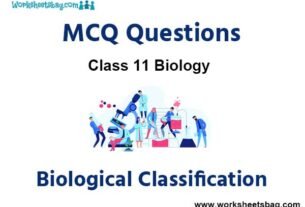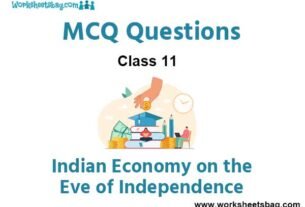Please refer to Chemical Bonding and Molecular Structure MCQ Questions Class 11 Chemistry below. These MCQ questions for Class 11 Chemistry with answers have been designed as per the latest NCERT, CBSE books, and syllabus issued for the current academic year. These objective questions for Chemical Bonding and Molecular Structure will help you to prepare for the exams and get more marks.
Chemical Bonding and Molecular Structure MCQ Questions Class 11 Chemistry
Please see solved MCQ Questions for Chemical Bonding and Molecular Structure in Class 11 Chemistry. All questions and answers have been prepared by expert faculty of standard 11 based on the latest examination guidelines.
MCQ Questions Class 11 Chemistry Chemical Bonding and Molecular Structure
Question. Which one of the following is a correct set?
(a) H2O, sp3, angular
(b) BCI3,sp3, angular
(c) NH+4, dsp2, square planar
(d) CH4, dsp2, tetrahedral
Answer
A
Question. The number of sigma and pi bonds in peroxodisu1phuric acid are respectively
(a) 9 and 4
(b) 11 and 4
(c) 4 and 8
(d) 4 and 9
Answer
B
Question. In which pair of species, both species do have the similar geometry?
(a) CO2 , SO2
(b) NH3 , BH3
(c) CO2-3 , SO2-3
(d) SO2-4 , CO–4
Answer
D
Question. The number of valence shell bonding electrons to be distributed in the Lewis electron dot model for HNNN is
(a) 6
(b) 10
(c) 11
(d) 16
Answer
B
Question. The shape of XeF4 molecule and hybridisation of xenon in it are
(a) tetrahedral and sp3
(b) square planar and dsp2
(c) square planar and sp3d2
(d) octahedral and sp3d2
Answer
C
Question. The percentage of p-character in the orbitals forming P—P bonds in P4 is
(a) 25
(b) 33
(c) 50
(d) 75
Answer
D
Question. In TeCI4 , the central atom tellurium involves
(a) sp3 hybridisation
(b) sp3d hybridisation
(c) sp3d2 hybridisation
(d) dsp2 hybridisation
Answer
B
Question. In BrF3 molecule, the lone pairs occupy equatorial positions to minimise
(a) lone pair-bond pair repulsion only
(b) bond pair-bond pair repulsion only
(c) lone pair-lone pair repulsion and lone pair-bond pair repulsion
(d) lone pair-lone pair repulsion only
Answer
C
Question. Among the following, the pair in which the two species are not isostructural, is
(a) SiF4 and SF4
(b) IO–3 and XeO3
(c) BH–4 and NH+4
(d) PF–6 and SF6
Answer
A
Question. Which one of the following compounds has sp2 hybridisation?
(a) CO2
(b) SO2
(c) N2O
(d) CO
Answer
B
Question. In a regular octahedral molecule, MX 6 the number of X — M — X bonds at 180° is
(a) three
(b) two
(c) six
(d) four
Answer
A
Question. H2O is di polar, whereas BeF2 is not. It is because
(a) the electronegativity ofF is greater than that of O
(b) H2O involves hydrogen bonding whereas BeF2 is a discrete molecule
(c) H2O is linear and BeF2 is angular
(d) H2O is angular and BeF2 is linear
Answer
D
Question. Which one of the following is paramagnetic?
(a) N2
(b) NO
(c) CO
(d) O3
Answer
B
Question. Assuming that Hund’s rule is violated, the bond order and magnetic nature of the diatomic molecule B2 is
(a) 1 and diamagnetic
(b) 0 and diamagnetic
(c) 1 and paramagnetic
(d) 0 and paramagnetic
Answer
A
Question. The bond order in NO is 2.5 while that in NO+ is 3. Which of the following statements is tme for these two species ?
(a) Bond length in NO– is greater than in NO
(b) Bond length in NO is greater than in NO+
(c) Bond length in NO– is equal to in NO
(d) Bond length is unpredictable
Answer
B
Question. In a homonuclear molecule which of the following set of orbitals is degenerate?
(a) σ2s and σ1s
(b) n2Px and n2py
(c) n2Px and σ2pz
(d) σ2pz and n2Px
Answer
B
Question. Which species has the highest bond order ?
(a) O2
(b) O2–2
(c) N2
(d) Both O2 and O2–2
Answer
C
Question. Peroxide ion
I. has five completely filled antibonding molecular orbitals
II. is diamagnetic
III. has bond order one
IV. is isoelectronic with neon
Which one of these is correct?
( a) II and III
(b) I, II and II
(c) I, II and III
(d) I and IV
Answer
A
Question. Given are O2 , o;, o~+ and o~-, respectively. Find the correct increasing bond order
(a) O2 < O22– < O2+2 < O+2
(b) O2+2 < O2< O+2 < O2+2
(c) O22– < O2 < O+2 < O2-2
(d) O+2 < O22– < O2 < O2+2
Answer
B
Question. The relationship between the dissociation energy of N2 and N+2 is
(a) dissociation energy of N2 = dissociation energy of N+2
(b) dissociation energy of N2 can either be lower or higher than the dissociation energy of N+2
(c) dissociation energy of N+2 > dissociation energy of N+2
(d) dissociation energy of N; > dissociation energy of N2
Answer
C
Question. The species having bond order different from that in CO is
(a) NO–
(b) NO+
(c) CN–
(d) N2
Answer
A
Question. The bond order of N+2 is
(a) 1.5
(b) 3.0
(c) 2.5
(d) 2.0
Answer
C
Question. The compound in which the number of dn-pn bonds are equal to those present in ClO4–
(a) XeF4
(b) XeO3
(c) XeO4
(d) XeF6
Answer
B
Question. The H-O-H bond angle in H2O is 104. 5°. This fact can be best explained with the help of
(a) valence shell electron pair I repulsion (VSEPR) theory
(b) molecular orbi tal theory
(c) presence of hydrogen bond
(d) electronegativity difference between hydrogen and oxygen atoms
Answer
A
Question. Which of the following groups all do not have sp3d hybridisation?
(a) ClF3 , IF3, XeF3+
(b) ICI2, ClF2, I3
(c) CIF3, BrF3, IF3
(d) PCl3, AsCI3, PF5
Answer
D
Question. The C—H bond distance is the longest in
(a) C2H6
(b) C2H2
(c) C2H2Br2
(d) C2H4
Answer
A
Question. In methane the bond angle is
(a) 180°
(b) 90°
(c) 109°
(d) 120°
Answer
C
Question. How many electron pairs are present in valence shell of oxygen in water molecule ?
(a) 4
(b) 1
(c) 2
(d) 3
Answer
A
Question. In which of the following compound sp2 hybridisation is absent ?
(a) CH2 = CH—CH= CH2
(b) CH = C—CH2—CH3
(c) CH2 —CH=CH2
(d) CH2 = CH—CH2—CH3
Answer
B
Question. The actual geometry of NO–2 is
(a) planar
(b) linear
(c) V-shape
(d) tetrahedral
Answer
C
Question. The C—O—H bond angle in ethanol is nearly
(a) 90°
(b) 104°
(c) 120°
(d) 180°
Answer
B
Question. C—C bond length is maximum in
(a) diamond
(b) graphite
(c) naphthalene
(d) fullerene
Answer
A
Question. In which of the following pairs of molecules/ions both the species are not likely to exist?
(a) H2+, He2–2
(b) H2–, He2–2
(c) H2+, He2
(d) H2–+, He2+2
Answer
C
Question. Which one of the following molecules is spected to exhibit diamagnetic behaviour?
(a) C2
(b) N2
(c) O2
(d) S2
Answer
A
Question. Stability of the species Li2 , Li2– and Li2+ increases in the order of
(a) Li2 < Li! < Li2
(c) Li2 < Li2 < Li!
(b) Li2 < Li! < Li2
(d) Li2 < Li2 < Li!
Answer
B
Question. The bond order in the superoxide ion (O–2) is
(a) 2.5
(b) 2
(c) 1.5
(d) 1
Answer
C
Question. Oxygen molecules contains
(a) no unpaired electron
(b) one unpaired electron
(c) two unpaired electrons
(d) three unpaired electrons
(e) four unpaired electrons
Answer
C
Question. The paramagnetic behaviour of B2 is due to the presence of
(a) two unpaired electrons in nb MO
(b) two unpaired electrons in n* MO
(c) two unpaired electrons in σ* MO
(d) two unpaired electrons in σb MO
Answer
A
Question. As per molecular orbital theory, which can’t exist in stable state?
(a) H2
(b) H+2
(c) H–2
(d) He2
Answer
D
Question. Which of the following is diamagnetic?
(a) H2
(b) H–2
(c) H+2
(d) He+2
Answer
B
Question. When O2 is converted into H+2
(a) both paramagnetic character and bond order increase
(b) bond order decreases
(c) paramagnetic character increases
(d) paramagnetic character decreases and the bond order increases
Answer
D
Question. Which of the following is not correct with respect to bond length of the species ?
(a) C2 > C2–2
(b) B+2 > B2
(C) O2 > O–2
(d) Nl+2 > N2
Answer
C
Question. According of VSEPR theory the repulsion between different pair (lone or bond) of electrons obey the order Codes
(a) lp – bp > Ip – Ip > bp – bp
(b) Ip – bp > bp – bp > Ip – Ip
(c) Ip – Ip > Ip – bp > bp – bp
(d) bp – bp > Ip – Ip > Ip – bp
Answer
C
Question. Bond angles of NH3 , PH3, AsH3 and SbH3 is in the order
(a) PH3 > AsH3 > SbH3 > NNH3
(b) SbH3 > AsH3 > PH3 > NH3
(c) SbH3 > AsH3 > NH3 > PH3
(d) NH3 > PH3 > AsH3 > SbH3
Answer
D
Question. Shape and hybridisation of IF5 respectively are
(a) trigonal bipyramidal, sp3d
(b) sea-saw, sp3d
(c) square pyramidal, sp3d2
(d) pentagonal pyramidal, sp3d3
Answer
C
Question. Which one of the following linear structure?
I.I3–
II NO2–
III. I3+
IV. S02
V. N3–
(a) I, II and III
(b) IandV
(c) II, III and IV
(d) All of these
Answer
B
Question. The total number of lone pairs of electrons in melamine is
(a) 4
(b) 7
(c) 6
(d) 9
Answer
C
Question. What type of hydridisation takes place in the N atom of NH3 ?
(a) sp2
(b) sp3
(c) dsp2
(d) sp
Answer
B
Question. In which of the following pairs the two species are not isostructural?
(a) CO2-3and NO3–
(b) PCl44and SiCl4
(c) PF3 and BrF5
(d) AlF3-6 and SF6
Answer
C
Question. In which reaction, the hybridisation on the central atom changes from sp2 to sp3 ?
(a) NH3 + H+ → NH4+
(b) BF3 + F– → BF4–
(c) H2O + H+ → H3O+
(d) C2H2 + 2H2 → C2H6
Answer
B
Question. How manycr σ and n bonds are present in given compound ?
Ph-CH=C—C2H5
l
CH3
(a) 19σ and 4n-bonds
(c) 25σ and 4n-bonds
(b) 22σ and 4n-bonds
(d) 26σ and 4n-bonds
Answer
C
Question. BCI3 is a planar molecule, while NCI3 is pyramidal, because
(a) N—Cl bond is more covalent than B—Cl bond
(b) nitrogen atom is smaller than boron atom
(c) B—Cl bond is more polar than N—Cl bond
(d) BCI3 has no lone pair of electrons but NCI3 has a lone pair of electrons
Answer
D
Question. Which one of the following compounds has the smallest bond angle in its molecule ?
(a) SO2
(b) H2O
(c) SH2
(d) NH3
Answer
C
Question. The molecular shapes of SF4 , CF4 and XeF4 are
(a) different with 1, 0 and 2 lone pairs of electrons on the central atom, respectively
(b) different with 0, l and 2 lone pairs of electrons on the central atom, respectively
(c) the same with 1, 1 and 1 lone pair of electrons on the central atoms, respectively
(d) the same with 2, 0 and 1 lone pairs of electrons on the central atom, respectively
Answer
A
Question. How many re-bonds are present in naphthalene?
(a) 4
(b) 5
(c) 6
(d) 7
Answer
B
Question. Valence bond theory of metallic bond was given by
(a) Dalton
(b) Drude!
(c) Fajan
(d) Pauling
Answer
D
Question. Which one of the following is a correct set with respect to molecule, hybridisation and shape ?
(a) BeCI2 , sp2, linear
(b) BeCI2 , sp2, triangular planar
(c) BCI3 , sp2, triangular planar
(d) BCI3 , sp3, tetrahedral
Answer
C
Question. In I-butene number of σ-bonds is
(a) 8
(b) 10
(c) 11
(d) 12
Answer
C
Question. Which of the following set of properties belong to PCl5 ?
(a) sp3, tetrahedral, 4 valence shell pairs of electrons
(b) sp3d, trigonal bipyramidal, 5 valence shell pairs of electrons
(c) sp3d2, octahedral, 6 valence she! II pairs of electrons
(d) sp3d, square planar, 4 valence shell pairs of electrons
Answer
B
Question. Which of the following is correct?
(a) The number of electrons present in the valence shell ofS in SF6 is 12
(b) The rates of ionic reactions are very slow
(c) According to VSEPR theory, SnCl2 is a linear molecule
(d) The correct order of ability to form ionic compounds among Na+, Mg2+ and Al3+ is Al3+ > Mg2+ > Na+
Answer
A
Question. The d-orbital involved in sp3 d-hybridisation is
(a) dx2- y2
(b) dxy
(c) dz2
(d) dzx
Answer
C
Question. Which of the following is planar?
(a) XeF2
(b) XeO3F
(c) XeO2F2
(d) XeF4
Answer
A
Question. The shape of sulphate ion is
(a) square planar
(b) trigonal
(c) trigonal planar
(d) tetrahedral
Answer
D
Question. Cl—P—Cl bond angles in PCI5 molecule are
(a) 120° and 90°
(b) 60° and 90°
(c) 60° and 120°
(d) 1200 and 30°
Answer
A
Question. Amongst the following, the molecule that is linear is
(a) SO2
(b) CO2
(c) ClO2
(d) NO2
Answer
B
Question. The bond angle in AsH3 is greater than that in
(a) NH3
(b) H2O
(c) BCl3
(d) None of these
Answer
D
Question. SF2, SF4 and SF6 have the hybridisations at sulphur atom respectively, as
(a) sp2, sp3, sp2d2
(b) sp3, sp3, sp3d2
(c) sp3, sp3d, sp3d2
(d) sp3,, spd2, d2sp3,
Answer
C
Question. In pyrophosphoric acid, H4P2O7 , number of σ and dn — pn bonds are respectively
( a) 8 and 2
(b) 6 and 2
(c) 12 and O
(d) 12 and 2
Answer
D
Question. The bond angle is smallest in
(a) H2O
(b) H2S
(c) BeCI2
(d) N2O
Answer
B
Question. Two type F XF angles are present in which of the following molecules? (X = S, Xe, C)
(a) SF4
(b) XeF4
(c) SF6
(d) CF4
Answer
A
Question. Number of lone pair(s) in XeOF4 is/are
(a) 0
(b) 1
(c) 2
(d) 3
Answer
B
Question. In which of the following molecules/ions all the bonds are not equal ?
(a) SF4
(b) SiF4
(c) XeF4
(d) BF4
Answer
A



